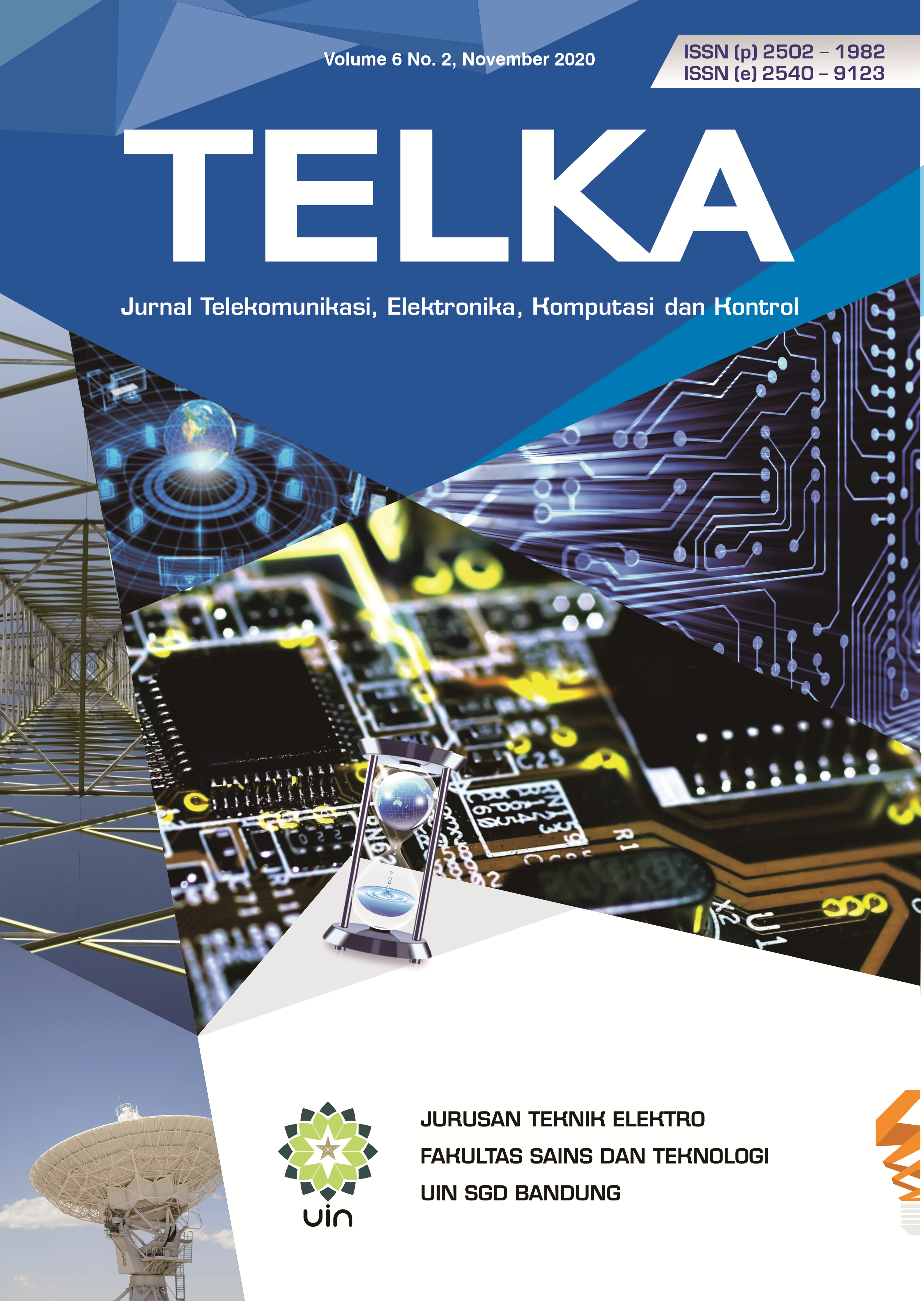Pengendali PID pada Motor DC dan Tuning Menggunakan Metode Differential Evolution (DE)
DOI:
https://doi.org/10.15575/telka.v6n2.147-159Kata Kunci:
PID controller, Motor DC, Pemyetelan, Diferensial EvolusiAbstrak
Penggunaan PID controller pada sistem industri sangat umum digunakan dalam menentukan kepresisian suatu feedback yang diberikan dengan keluaran sesuai dengan keinginan pengguna. Namun pada umumnya optimalisasi masih menggunakan cara manual yaitu trial dan error pada tuning gain terhadap nilai Kp, Ki, dan Kd. Kendala tersebut dapat diatasi dengan melakukan pendekatan fungsi dan mengaplikasikan nilai tuning dengan metode Diferensial Evolusi. Penggunaaan tuning PID pada implementasinya menggunakan motor DC untuk menentukan kecepatan putar motor dengan keluaran yang stabil. Hasil yang didapatkan berupa sinyal keluaran atau respon sistem terhadap putaran motor DC dengan menampilkan nilai risetime, settlingtime, dan overshoot. Pengoptimalan nilai dilakukan dengan pencarian nilai terbaik pada setiap iterasi dan diaplikasikan sebagai tuning Kp, Ki, dan Kd tanpa harus melakukan cara manual. Hasil pengujian parameter Diferensial Evolusi menunjukkan efesiensi pengoptimalan tuning dan memberikan hasil keluaran yang baik dengan implementasinya terhadap plan hardware motor DC.
The use of PID in industrial systems is very commonly used in determining the optimal accuracy of the output. However, several studies still uses manual methods for the optimization, namely trial and error on tuning gain with values of Kp, Ki, and Kd. This problem could be overcome applying the tuning value with the Evolution Differential method. The use of PID tuning in its implementation in this study uses a DC motor to determine the rotational speed of the motor with a stable output. Based on the results, we can see the value of rise time, settling time, and overshoot based on an output signals. The optimization was done by finding the best value in iteration and applying it as Kp, Ki, and Kd tuning without having to do the manual method. The results of testing the Differential Evolution parameters show the efficiency of tuning optimization and provide good output with the implementation of the DC motor hardware plan.
Referensi
A. Gosh, S. Das, R. Mallipeddi, A. K. Das, and S. S. Dash, “A Modified Differential Evolution with Distance-based Selection for Continuous Optimization in Presence of Noise,” IEEE Access, vol. 5, pp. 26944–26964, 2017, doi: 10.1109/ACCESS.2017.2773825.
A. Ma’Arif, H. Nabila, Iswanto, and O. Wahyunggoro, “Application of Intelligent Search Algorithms in Proportional-Integral-Derivative Control of Direct-Current Motor System,” J. Phys. Conf. Ser., vol. 1373, no. 1, 2019, doi: 10.1088/1742-6596/1373/1/012039.
B. Guan, Y. Zhao, and Y. Li, “DESeeker: Detecting Epistatic Interactions Using a Two-Stage Differential Evolution Algorithm,” IEEE Access, vol. 7, pp. 69604–69613, 2019, doi: 10.1109/ACCESS.2019.2917132.
B. Yang, Z. Zhang, and Z. Sun, “Computing Nonlinear LTS Estimator Based on a Random Differential Evolution Strategy,” Tsinghua Sci. Technol., vol. 13, no. 1, pp. 59–64, 2008, doi: 10.1016/S1007-0214(08)70010-5.
FAHMIZAL, F. et al. (2019) ‘Robot Inverted Pendulum Beroda Dua (IPBD) dengan Kendali Linear Quadratic Regulator (LQR)’, ELKOMIKA: Jurnal Teknik Energi Elektrik, Teknik Telekomunikasi, & Teknik Elektronika. doi: 10.26760/elkomika.v7i2.224, 7(2), pp. 224-237.
L. U. Factor, “Congestion Management of Power System with Interline Power Flow Controller Using Disparity,” vol. 1, no. 3, pp. 76–85, 2015M. G. Villarreal-Cervantes, A. Rodriguez-Molina, C. V. Garcia-Mendoza, O.
Penaloza-Mejia, and G. Sepulveda-Cervantes, “Multi-Objective On-Line Optimization Approach for the DC Motor Controller Tuning Using Differential Evolution,” IEEE Access, vol. 5, pp. 20393–20407, 2017, doi: 10.1109/ACCESS.2017.2757959.
R. A. Sarker, S. M. Elsayed, and T. Ray, “Differential evolution with dynamic parameters selection for optimization problems,” IEEE Trans. Evol. Comput., vol. 18, no. 5, pp. 689–707, 2014, doi: 10.1109/TEVC.2013.2281528.
W. Lianghong, W. Yaonan, Z. Shaowu, and T. Wen, “Design of PID controller with incomplete derivation based on differential evolution algorithm,” J. Syst. Eng. Electron., vol. 19, no. 3, pp. 578–583, 2008, doi: 10.1016/s1004-4132(08)60123-1.
W. Shahzad, Y. Ahsan, and E. Ahmed, “Drug Design and Discovery using Differential Evolution,” J. Appl. Environ. Biol. Sci., vol. 6, no. 12, pp. 16–26.
Y. L. Li, Z. H. Zhan, Y. J. Gong, W. N. Chen, J. Zhang, and Y. Li, “Differential Evolution with an Evolution Path: A DEEP Evolutionary Algorithm,” IEEE Trans. Cybern., vol. 45, no. 9, pp. 1798–1810, 2015, doi: 10.1109/TCYB.2014.2360752.













